(Page créée avec « So to assemble this shelf, refer to the manual provided by Ikea. ») |
(Mise à jour pour être en accord avec la nouvelle version de la source de la page) |
||
| (98 révisions intermédiaires par 3 utilisateurs non affichées) | |||
| Ligne 2 : | Ligne 2 : | ||
|Main_Picture=Meuble_lavabo_low_tech_IMG_20200726_140851.jpg | |Main_Picture=Meuble_lavabo_low_tech_IMG_20200726_140851.jpg | ||
|Licences=Attribution-ShareAlike (CC BY-SA) | |Licences=Attribution-ShareAlike (CC BY-SA) | ||
| − | |Description= | + | |Description=Self-sustained Sink Suitable for Both Children and Adults |
|Area=Habitat, Water, Hygiene | |Area=Habitat, Water, Hygiene | ||
|Type=Tutorial | |Type=Tutorial | ||
| Ligne 10 : | Ligne 10 : | ||
|Cost=190 | |Cost=190 | ||
|Currency=EUR (€) | |Currency=EUR (€) | ||
| − | |Tags=Bois, Eau, Hygiène, Propreté, Lavage des mains, Pompe, Lavabo, Vaisselle, Covid 19, Enfants, Montessori, Autonomie | + | |Tags=Bois, Eau, Hygiène, Propreté, Lavage des mains, Pompe, Lavabo, Vaisselle, Covid 19, Enfants, Montessori, Autonomie, Sink |
}} | }} | ||
{{Introduction | {{Introduction | ||
| − | |Introduction=This "autonomous" sink was originally created for a nursery school classroom. | + | |Introduction=This "autonomous" sink was originally created for a nursery school classroom. |
| − | The classroom | + | The classroom didn't have a water line connection, and we didn't want the sink to rely on electricity either. This idea emerged in the COVID era and its concern with sanitation. |
| − | We conceived of this sink with the idea that it could equally serve in other contexts, | + | We conceived of this sink with the idea that it could equally serve in other contexts, a stand-alone workshop or studio, for example. |
We opted, then, for a shelving system that could be adjusted in height, permitting the user to adjust it to the desired size. | We opted, then, for a shelving system that could be adjusted in height, permitting the user to adjust it to the desired size. | ||
| Ligne 41 : | Ligne 41 : | ||
}} | }} | ||
{{Tuto Step | {{Tuto Step | ||
| − | |Step_Title=Assemble the | + | |Step_Title=Assemble the Shelf |
| − | |Step_Content=For the shelf, the most | + | |Step_Content=For the shelf, the most autonomous action would obviously be to do it yourself, but we are focused on assembly from existing materials. |
| − | So to assemble this shelf, refer to the manual provided by Ikea. | + | So, to assemble this shelf, refer to the manual provided by Ikea. |
|Step_Picture_00=Meuble_lavabo_low_tech_IMG_20200726_100553.jpg | |Step_Picture_00=Meuble_lavabo_low_tech_IMG_20200726_100553.jpg | ||
}} | }} | ||
{{Tuto Step | {{Tuto Step | ||
| − | |Step_Title= | + | |Step_Title=Install the Sink into the Shelf |
| − | |Step_Content=''' | + | |Step_Content='''Materials''' |
| − | |||
| − | |||
| − | |||
| − | |||
| − | |||
| − | |||
| − | |||
| − | |||
| + | *Masking tape | ||
| + | *Ruler | ||
| + | *Square | ||
| + | *Tape Measure | ||
| + | *Drill | ||
| + | *10mm drill bit | ||
| + | *Jigsaw | ||
| − | ''' | + | '''Directions''' |
| − | # | + | #Plot the outline of the part of the sink to be inserted on the non-visible side of the board (the underside). |
| − | # | + | #Drill a hole on each of the 4 corners of the outline |
| − | # | + | #Cut out the outline with the jigsaw |
| − | # | + | #Insert the sink |
| − | # | + | #Install the shelf with the sink at the desired height according to the size of the children or adults |
| − | {{Idea|... | + | {{Idea|...Using masking tape to make the pencil outline can allow you to bypass making marks on the wood.}}<br /> |
|Step_Picture_00=Meuble_lavabo_low_tech_IMG_20200726_103217.jpg | |Step_Picture_00=Meuble_lavabo_low_tech_IMG_20200726_103217.jpg | ||
|Step_Picture_01=Meuble_lavabo_low_tech_scie_sauteuse_et_perceuse.jpg | |Step_Picture_01=Meuble_lavabo_low_tech_scie_sauteuse_et_perceuse.jpg | ||
| Ligne 76 : | Ligne 75 : | ||
}} | }} | ||
{{Tuto Step | {{Tuto Step | ||
| − | |Step_Title= | + | |Step_Title=Install the Fitting for the Clean Water Bucket |
| − | |Step_Content=''' | + | |Step_Content='''Materials''' |
| − | * | + | *Auer plastic food safe bucket - 30 liters |
| − | * | + | *Masking tape |
| − | * | + | *Ruler |
| − | * | + | *Tape measure |
| − | * | + | *Step drill bit |
| − | * | + | *Fitting - 12mm diameter, 1/2", straight (not curved) |
| − | ''' | + | '''Directions''' '''<br />''' |
| − | # | + | #Mark the location of the fitting on the lowest end of the bucket. |
| − | # | + | #Drill the bucket with the step drill bit. |
| − | # | + | #Screw the fitting in. Attach the gasket and nut to the fitting inside the bucket. |
| − | {{Info|...... | + | {{Info|......Be careful to leave enough space for the nut which is bigger than the fitting.}} |
|Step_Picture_00=Meuble_lavabo_low_tech_IMG_20200726_105214.jpg | |Step_Picture_00=Meuble_lavabo_low_tech_IMG_20200726_105214.jpg | ||
|Step_Picture_01=Meuble_lavabo_low_tech_IMG_20200726_103813.jpg | |Step_Picture_01=Meuble_lavabo_low_tech_IMG_20200726_103813.jpg | ||
| Ligne 100 : | Ligne 99 : | ||
}} | }} | ||
{{Tuto Step | {{Tuto Step | ||
| − | |Step_Title= | + | |Step_Title=Connect the Tubes |
| − | |Step_Content=''' | + | |Step_Content='''Materials''' |
| − | * | + | *Clear tubing 16/12mm (120cm + 20cm) |
| − | * | + | *Clear tubing 12/10mm (40cm) |
| − | * | + | *Plastic reducing adapter 12/10mm |
| − | * | + | *Foot pump |
| − | * | + | *Swivel spout tap |
| − | {{Info|... | + | {{Info|...To avoid dealing with multiple suppliers, we got the majority of the specialized materials concerning the sink on the site www.mon-camping-car.com We didn't find exactly everything we needed there. The foot pump is 12mm and the tap is 10mm, so we had to use two types of clear tubing and an adapter to get the right dimensions for the tap}} |
| − | ''' | + | '''Directions''' |
| − | # | + | #Connect the clean water bucket to the foot pump. Attach the 16/12 (1.2 meters) tube to the nozzle of the clean water bucket. Then, connect the 16/12 tube to the foot pump (The nozzle on the right when viewed from the bottom (water intake)). |
| − | # | + | #Connect the foot pump to the swivel spout tap. Link the 16/12 (20cm) tube from the foot pump to the adapter and then to the 10/12 (40cm) clear tube which goes toward the swivel spout tap. |
|Step_Picture_00=Meuble_lavabo_low_tech_IMG_20200726_111945.jpg | |Step_Picture_00=Meuble_lavabo_low_tech_IMG_20200726_111945.jpg | ||
|Step_Picture_01=Meuble_lavabo_low_tech_IMG_20200726_100504.jpg | |Step_Picture_01=Meuble_lavabo_low_tech_IMG_20200726_100504.jpg | ||
| Ligne 121 : | Ligne 120 : | ||
}} | }} | ||
{{Tuto Step | {{Tuto Step | ||
| − | |Step_Title= | + | |Step_Title=Leak Test the Connections |
| − | |Step_Content= | + | |Step_Content=Using 5 litres of water placed in the clean water bucket, test the watertightness of the system in place. |
| − | {{Info|... | + | {{Info|...We have not, for the time being, used hose clamps or zip ties for setting the tubes, to see whether or not they are necessary for usage.}}<br /> |
|Step_Picture_00=Meuble_lavabo_low_tech_IMG_20200726_112343.jpg | |Step_Picture_00=Meuble_lavabo_low_tech_IMG_20200726_112343.jpg | ||
}} | }} | ||
{{Tuto Step | {{Tuto Step | ||
| − | |Step_Title= | + | |Step_Title=Attach the Swivel Spout Tap to the Shelf |
| − | |Step_Content=''' | + | |Step_Content='''Materials''' |
| − | * | + | *Drill |
| − | * | + | *Drill bits |
| − | * | + | *Swivel spout tap |
| − | ''' | + | '''Directions''' |
| − | # | + | #Mark the location and drill a hole using a size 18 flat wood bit |
| − | # | + | #Make a countersink hole using a size 39 flat wood bit on the bottom of the board. |
| − | # | + | #Screw the base of the tap into the board and install the spout. |
| − | {{Info|... | + | {{Info|...The threaded stem of the tap was too tight against the thickness of the chosen wood board, so a slight widening was necessary.}} |
|Step_Picture_00=Meuble_lavabo_low_tech_IMG_20200726_120305.jpg | |Step_Picture_00=Meuble_lavabo_low_tech_IMG_20200726_120305.jpg | ||
|Step_Picture_01=Meuble_lavabo_low_tech_IMG_20200726_112841.jpg | |Step_Picture_01=Meuble_lavabo_low_tech_IMG_20200726_112841.jpg | ||
| Ligne 150 : | Ligne 149 : | ||
}} | }} | ||
{{Tuto Step | {{Tuto Step | ||
| − | |Step_Title= | + | |Step_Title=Fasten the Drain and Plug to the Sink |
| − | |Step_Content=''' | + | |Step_Content='''Materials''' |
| − | * | + | *Straight sink drain 25mm |
|Step_Picture_00=Meuble_lavabo_low_tech_IMG_20200726_120503.jpg | |Step_Picture_00=Meuble_lavabo_low_tech_IMG_20200726_120503.jpg | ||
|Step_Picture_01=Meuble_lavabo_low_tech_IMG_20200726_120515.jpg | |Step_Picture_01=Meuble_lavabo_low_tech_IMG_20200726_120515.jpg | ||
}} | }} | ||
{{Tuto Step | {{Tuto Step | ||
| − | |Step_Title= | + | |Step_Title=Install Sink-Stopper Chain and Metal Fastener (optional) |
|Step_Content= | |Step_Content= | ||
|Step_Picture_00=Meuble_lavabo_low_tech_IMG_20200726_122625.jpg | |Step_Picture_00=Meuble_lavabo_low_tech_IMG_20200726_122625.jpg | ||
| Ligne 164 : | Ligne 163 : | ||
}} | }} | ||
{{Tuto Step | {{Tuto Step | ||
| − | |Step_Title= | + | |Step_Title=Installing Wastewater Drainage |
| − | |Step_Content=''' | + | |Step_Content='''Materials''' |
| − | * | + | *Jerrycan/fuel can 20 litres |
| − | * | + | *Ribbed hosing - 25mm diameter 90cm length |
| − | * | + | *Drill with step drill bits |
| − | * | + | *Straight drain and plug 25mm |
| − | * | + | *PVC fastener 40mm. 4 x 30 screw |
| − | ''' | + | '''Directions''' |
| − | # | + | #Drill a 32mm hole into the lid of the jerrycan with the flat drill bit and drill. |
| − | # | + | #Connect the sink drain to the jerrycan. |
| − | # | + | #Install a 40mm diameter PVC fastener for the drainage hose. "(When the jerrycan is full and it's time to empty it, this fastener allows you to keep the hose raised, which prevents the water remaining in the hose from spilling on the floor, which happened on our first use...)" |
| − | # | + | #Install and test the drainage system. |
| − | {{Idea|... | + | {{Idea|...Put a Colson hose clamp (zip tie) on the ribbed hose on the interior of the jerrycan. |
| − | + | This stops the children from removing the drainage hose from the water.}} | |
|Step_Picture_00=Meuble_lavabo_low_tech_IMG_20200726_121050.jpg | |Step_Picture_00=Meuble_lavabo_low_tech_IMG_20200726_121050.jpg | ||
|Step_Picture_01=Meuble_lavabo_low_tech_IMG_20200726_111004.jpg | |Step_Picture_01=Meuble_lavabo_low_tech_IMG_20200726_111004.jpg | ||
| Ligne 189 : | Ligne 188 : | ||
}} | }} | ||
{{Tuto Step | {{Tuto Step | ||
| − | |Step_Title= | + | |Step_Title=Anti-Tip System |
| − | |Step_Content=''' | + | |Step_Content='''Materials''' |
| − | |||
| − | |||
| − | |||
| − | |||
| − | |||
| + | *Wood board 64cm x 14cm x 22mm | ||
| + | *2 flat angle brackets 40mm | ||
| + | *4 wood screws 4 x 20 | ||
| + | {{Info|...Double use for this board. While it fixes the pedal in place, it also creates an anti-tipping system for the shelf. This could also be reinforced by fixing the shelf directly to the wall.}} | ||
| − | + | Two possible options: one being to fix the board to the feet of the shelf, the other being for the more handy, to make a cut-out to embed the feet of the shelf into the anti-tipping board. We present here the second choice. | |
| − | # | + | #Trace and then cut out the outlines of the feet of the shelf by drilling then cutting the portions out with a jigsaw. |
| − | # | + | #Fix the board to the shelf with two flat angle brackets. |
| − | {{Info|... | + | {{Info|...To be permanently attached after having fixed the foot pump in place.}} |
|Step_Picture_00=Meuble_lavabo_low_tech_affiche.jpg | |Step_Picture_00=Meuble_lavabo_low_tech_affiche.jpg | ||
|Step_Picture_01=Meuble_lavabo_low_tech_IMG_20200726_131814.jpg | |Step_Picture_01=Meuble_lavabo_low_tech_IMG_20200726_131814.jpg | ||
| Ligne 210 : | Ligne 208 : | ||
}} | }} | ||
{{Tuto Step | {{Tuto Step | ||
| − | |Step_Title= | + | |Step_Title=Fixing the Foot Pump in Place |
| − | |Step_Content=''' | + | |Step_Content='''Materials''' |
| − | * 2 | + | *2 stainless steel screws with tapered head M5 x 30mm |
|Step_Picture_00=Meuble_lavabo_low_tech_IMG_20200726_133729.jpg | |Step_Picture_00=Meuble_lavabo_low_tech_IMG_20200726_133729.jpg | ||
}} | }} | ||
{{Tuto Step | {{Tuto Step | ||
| − | |Step_Title= | + | |Step_Title=Treating the Wood |
| − | |Step_Content= | + | |Step_Content=In order to protect the wood from splashes, it was treated with a hard oil, in two coats. |
|Step_Picture_00=Meuble_lavabo_low_tech_lavabo.jpg | |Step_Picture_00=Meuble_lavabo_low_tech_lavabo.jpg | ||
|Step_Picture_00_annotation={"version":"2.4.6","objects":[{"type":"image","version":"2.4.6","originX":"left","originY":"top","left":0,"top":0,"width":3233,"height":1819,"fill":"rgb(0,0,0)","stroke":null,"strokeWidth":0,"strokeDashArray":null,"strokeLineCap":"butt","strokeDashOffset":0,"strokeLineJoin":"miter","strokeMiterLimit":4,"scaleX":0.19,"scaleY":0.19,"angle":0,"flipX":false,"flipY":false,"opacity":1,"shadow":null,"visible":true,"clipTo":null,"backgroundColor":"","fillRule":"nonzero","paintFirst":"fill","globalCompositeOperation":"source-over","transformMatrix":null,"skewX":0,"skewY":0,"crossOrigin":"","cropX":0,"cropY":0,"src":"https://wiki.lowtechlab.org/images/9/93/Meuble_lavabo_low_tech_lavabo.jpg","filters":[]},{"type":"wfarrow2line","version":"2.4.6","originX":"center","originY":"center","left":1,"top":222,"width":100,"height":0,"fill":"rgba(255,0,0,0)","stroke":"#FF0000","strokeWidth":4,"strokeDashArray":null,"strokeLineCap":"round","strokeDashOffset":0,"strokeLineJoin":"miter","strokeMiterLimit":4,"scaleX":1,"scaleY":1,"angle":0,"flipX":false,"flipY":false,"opacity":1,"shadow":null,"visible":true,"clipTo":null,"backgroundColor":"","fillRule":"nonzero","paintFirst":"fill","globalCompositeOperation":"source-over","transformMatrix":null,"skewX":0,"skewY":0,"x1":-50,"x2":50,"y1":0,"y2":0,"x2a":30,"y2a":-8,"x2b":30,"y2b":8},{"type":"wfarrow2circle","version":"2.4.6","originX":"center","originY":"center","left":-49,"top":222,"width":16,"height":16,"fill":"#aaa","stroke":"#666","strokeWidth":0,"strokeDashArray":null,"strokeLineCap":"butt","strokeDashOffset":0,"strokeLineJoin":"miter","strokeMiterLimit":4,"scaleX":1,"scaleY":1,"angle":0,"flipX":false,"flipY":false,"opacity":0.5,"shadow":null,"visible":true,"clipTo":null,"backgroundColor":"","fillRule":"nonzero","paintFirst":"fill","globalCompositeOperation":"source-over","transformMatrix":null,"skewX":0,"skewY":0,"radius":8,"startAngle":0,"endAngle":6.283185307179586},{"type":"wfarrow2circle","version":"2.4.6","originX":"center","originY":"center","left":51,"top":222,"width":16,"height":16,"fill":"#aaa","stroke":"#666","strokeWidth":0,"strokeDashArray":null,"strokeLineCap":"butt","strokeDashOffset":0,"strokeLineJoin":"miter","strokeMiterLimit":4,"scaleX":1,"scaleY":1,"angle":0,"flipX":false,"flipY":false,"opacity":0.5,"shadow":null,"visible":true,"clipTo":null,"backgroundColor":"","fillRule":"nonzero","paintFirst":"fill","globalCompositeOperation":"source-over","transformMatrix":null,"skewX":0,"skewY":0,"radius":8,"startAngle":0,"endAngle":6.283185307179586}],"height":338,"width":600} | |Step_Picture_00_annotation={"version":"2.4.6","objects":[{"type":"image","version":"2.4.6","originX":"left","originY":"top","left":0,"top":0,"width":3233,"height":1819,"fill":"rgb(0,0,0)","stroke":null,"strokeWidth":0,"strokeDashArray":null,"strokeLineCap":"butt","strokeDashOffset":0,"strokeLineJoin":"miter","strokeMiterLimit":4,"scaleX":0.19,"scaleY":0.19,"angle":0,"flipX":false,"flipY":false,"opacity":1,"shadow":null,"visible":true,"clipTo":null,"backgroundColor":"","fillRule":"nonzero","paintFirst":"fill","globalCompositeOperation":"source-over","transformMatrix":null,"skewX":0,"skewY":0,"crossOrigin":"","cropX":0,"cropY":0,"src":"https://wiki.lowtechlab.org/images/9/93/Meuble_lavabo_low_tech_lavabo.jpg","filters":[]},{"type":"wfarrow2line","version":"2.4.6","originX":"center","originY":"center","left":1,"top":222,"width":100,"height":0,"fill":"rgba(255,0,0,0)","stroke":"#FF0000","strokeWidth":4,"strokeDashArray":null,"strokeLineCap":"round","strokeDashOffset":0,"strokeLineJoin":"miter","strokeMiterLimit":4,"scaleX":1,"scaleY":1,"angle":0,"flipX":false,"flipY":false,"opacity":1,"shadow":null,"visible":true,"clipTo":null,"backgroundColor":"","fillRule":"nonzero","paintFirst":"fill","globalCompositeOperation":"source-over","transformMatrix":null,"skewX":0,"skewY":0,"x1":-50,"x2":50,"y1":0,"y2":0,"x2a":30,"y2a":-8,"x2b":30,"y2b":8},{"type":"wfarrow2circle","version":"2.4.6","originX":"center","originY":"center","left":-49,"top":222,"width":16,"height":16,"fill":"#aaa","stroke":"#666","strokeWidth":0,"strokeDashArray":null,"strokeLineCap":"butt","strokeDashOffset":0,"strokeLineJoin":"miter","strokeMiterLimit":4,"scaleX":1,"scaleY":1,"angle":0,"flipX":false,"flipY":false,"opacity":0.5,"shadow":null,"visible":true,"clipTo":null,"backgroundColor":"","fillRule":"nonzero","paintFirst":"fill","globalCompositeOperation":"source-over","transformMatrix":null,"skewX":0,"skewY":0,"radius":8,"startAngle":0,"endAngle":6.283185307179586},{"type":"wfarrow2circle","version":"2.4.6","originX":"center","originY":"center","left":51,"top":222,"width":16,"height":16,"fill":"#aaa","stroke":"#666","strokeWidth":0,"strokeDashArray":null,"strokeLineCap":"butt","strokeDashOffset":0,"strokeLineJoin":"miter","strokeMiterLimit":4,"scaleX":1,"scaleY":1,"angle":0,"flipX":false,"flipY":false,"opacity":0.5,"shadow":null,"visible":true,"clipTo":null,"backgroundColor":"","fillRule":"nonzero","paintFirst":"fill","globalCompositeOperation":"source-over","transformMatrix":null,"skewX":0,"skewY":0,"radius":8,"startAngle":0,"endAngle":6.283185307179586}],"height":338,"width":600} | ||
}} | }} | ||
{{Notes | {{Notes | ||
| − | |Notes= | + | |Notes=List of materials and links to suppliers : [https://docs.google.com/spreadsheets/d/e/2PACX-1vS8ihZ2bF19PcxR8sor0eoATqa6mUpuVbr4DJ6KYXoXsZpvRhNIQhXjW-v7nskOCtYI-nT_CwLolmLx/pubhtml Google Docs] |
| + | |||
| + | English translation by Katia Krussel. | ||
}} | }} | ||
{{PageLang | {{PageLang | ||
Version actuelle datée du 12 décembre 2020 à 00:23
Description
Self-sustained Sink Suitable for Both Children and Adults
Sommaire
Sommaire
- 1 Description
- 2 Sommaire
- 3 Introduction
- 4 Étape 1 - Assemble the Shelf
- 5 Étape 2 - Install the Sink into the Shelf
- 6 Étape 3 - Install the Fitting for the Clean Water Bucket
- 7 Étape 4 - Connect the Tubes
- 8 Étape 5 - Leak Test the Connections
- 9 Étape 6 - Attach the Swivel Spout Tap to the Shelf
- 10 Étape 7 - Fasten the Drain and Plug to the Sink
- 11 Étape 8 - Install Sink-Stopper Chain and Metal Fastener (optional)
- 12 Étape 9 - Installing Wastewater Drainage
- 13 Étape 10 - Anti-Tip System
- 14 Étape 11 - Fixing the Foot Pump in Place
- 15 Étape 12 - Treating the Wood
- 16 Notes et références
- 17 Commentaires
Introduction
This "autonomous" sink was originally created for a nursery school classroom.
The classroom didn't have a water line connection, and we didn't want the sink to rely on electricity either. This idea emerged in the COVID era and its concern with sanitation.
We conceived of this sink with the idea that it could equally serve in other contexts, a stand-alone workshop or studio, for example.
We opted, then, for a shelving system that could be adjusted in height, permitting the user to adjust it to the desired size.Étape 1 - Assemble the Shelf
For the shelf, the most autonomous action would obviously be to do it yourself, but we are focused on assembly from existing materials.
So, to assemble this shelf, refer to the manual provided by Ikea.
Étape 2 - Install the Sink into the Shelf
Materials
- Masking tape
- Ruler
- Square
- Tape Measure
- Drill
- 10mm drill bit
- Jigsaw
Directions
- Plot the outline of the part of the sink to be inserted on the non-visible side of the board (the underside).
- Drill a hole on each of the 4 corners of the outline
- Cut out the outline with the jigsaw
- Insert the sink
- Install the shelf with the sink at the desired height according to the size of the children or adults
Étape 3 - Install the Fitting for the Clean Water Bucket
Materials
- Auer plastic food safe bucket - 30 liters
- Masking tape
- Ruler
- Tape measure
- Step drill bit
- Fitting - 12mm diameter, 1/2", straight (not curved)
Directions
- Mark the location of the fitting on the lowest end of the bucket.
- Drill the bucket with the step drill bit.
- Screw the fitting in. Attach the gasket and nut to the fitting inside the bucket.
Étape 4 - Connect the Tubes
Materials
- Clear tubing 16/12mm (120cm + 20cm)
- Clear tubing 12/10mm (40cm)
- Plastic reducing adapter 12/10mm
- Foot pump
- Swivel spout tap
Directions
- Connect the clean water bucket to the foot pump. Attach the 16/12 (1.2 meters) tube to the nozzle of the clean water bucket. Then, connect the 16/12 tube to the foot pump (The nozzle on the right when viewed from the bottom (water intake)).
- Connect the foot pump to the swivel spout tap. Link the 16/12 (20cm) tube from the foot pump to the adapter and then to the 10/12 (40cm) clear tube which goes toward the swivel spout tap.
Étape 5 - Leak Test the Connections
Using 5 litres of water placed in the clean water bucket, test the watertightness of the system in place.
Étape 6 - Attach the Swivel Spout Tap to the Shelf
Materials
- Drill
- Drill bits
- Swivel spout tap
Directions
- Mark the location and drill a hole using a size 18 flat wood bit
- Make a countersink hole using a size 39 flat wood bit on the bottom of the board.
- Screw the base of the tap into the board and install the spout.
Étape 9 - Installing Wastewater Drainage
Materials
- Jerrycan/fuel can 20 litres
*Ribbed hosing - 25mm diameter 90cm length
- Drill with step drill bits
- Straight drain and plug 25mm
- PVC fastener 40mm. 4 x 30 screw
Directions
- Drill a 32mm hole into the lid of the jerrycan with the flat drill bit and drill.
- Connect the sink drain to the jerrycan.
- Install a 40mm diameter PVC fastener for the drainage hose. "(When the jerrycan is full and it's time to empty it, this fastener allows you to keep the hose raised, which prevents the water remaining in the hose from spilling on the floor, which happened on our first use...)"
- Install and test the drainage system.
Étape 10 - Anti-Tip System
Materials
- Wood board 64cm x 14cm x 22mm
- 2 flat angle brackets 40mm
- 4 wood screws 4 x 20
Two possible options: one being to fix the board to the feet of the shelf, the other being for the more handy, to make a cut-out to embed the feet of the shelf into the anti-tipping board. We present here the second choice.
- Trace and then cut out the outlines of the feet of the shelf by drilling then cutting the portions out with a jigsaw.
- Fix the board to the shelf with two flat angle brackets.
Étape 11 - Fixing the Foot Pump in Place
Materials
- 2 stainless steel screws with tapered head M5 x 30mm
Étape 12 - Treating the Wood
In order to protect the wood from splashes, it was treated with a hard oil, in two coats.
Notes et références
List of materials and links to suppliers : Google Docs
English translation by Katia Krussel.
Published
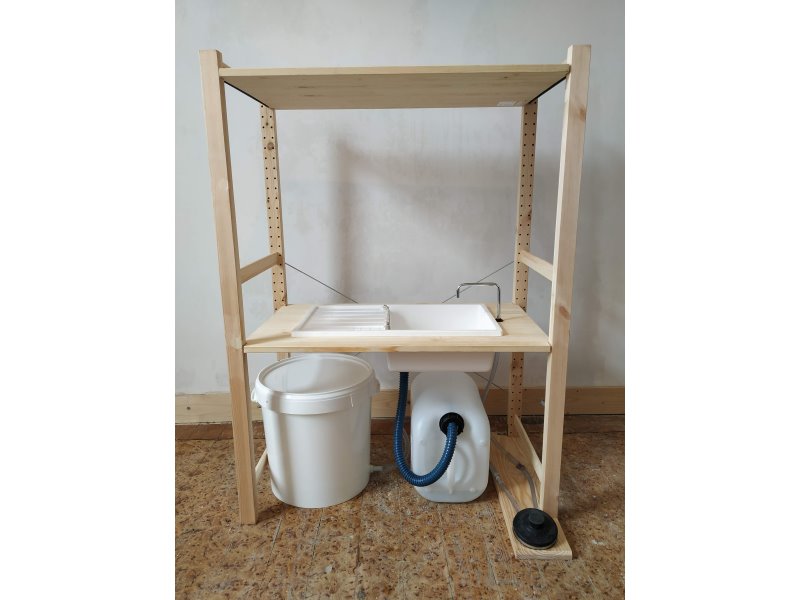
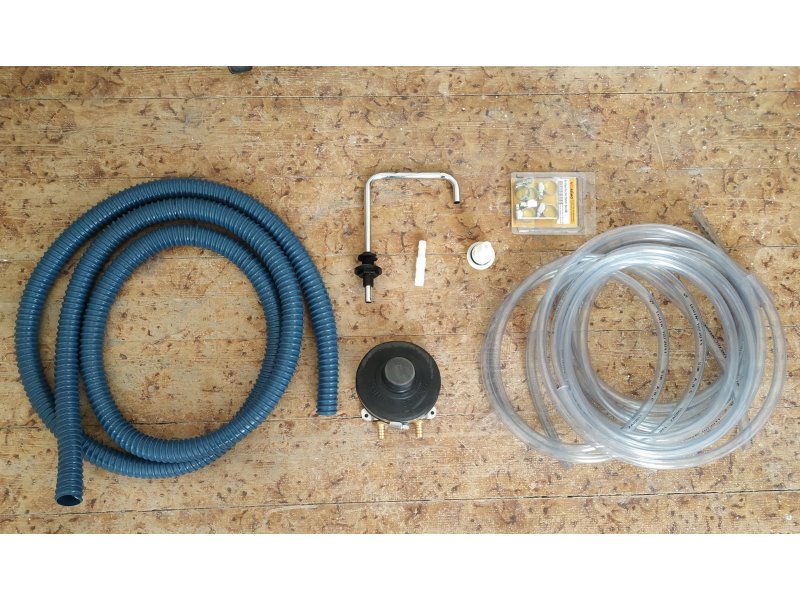
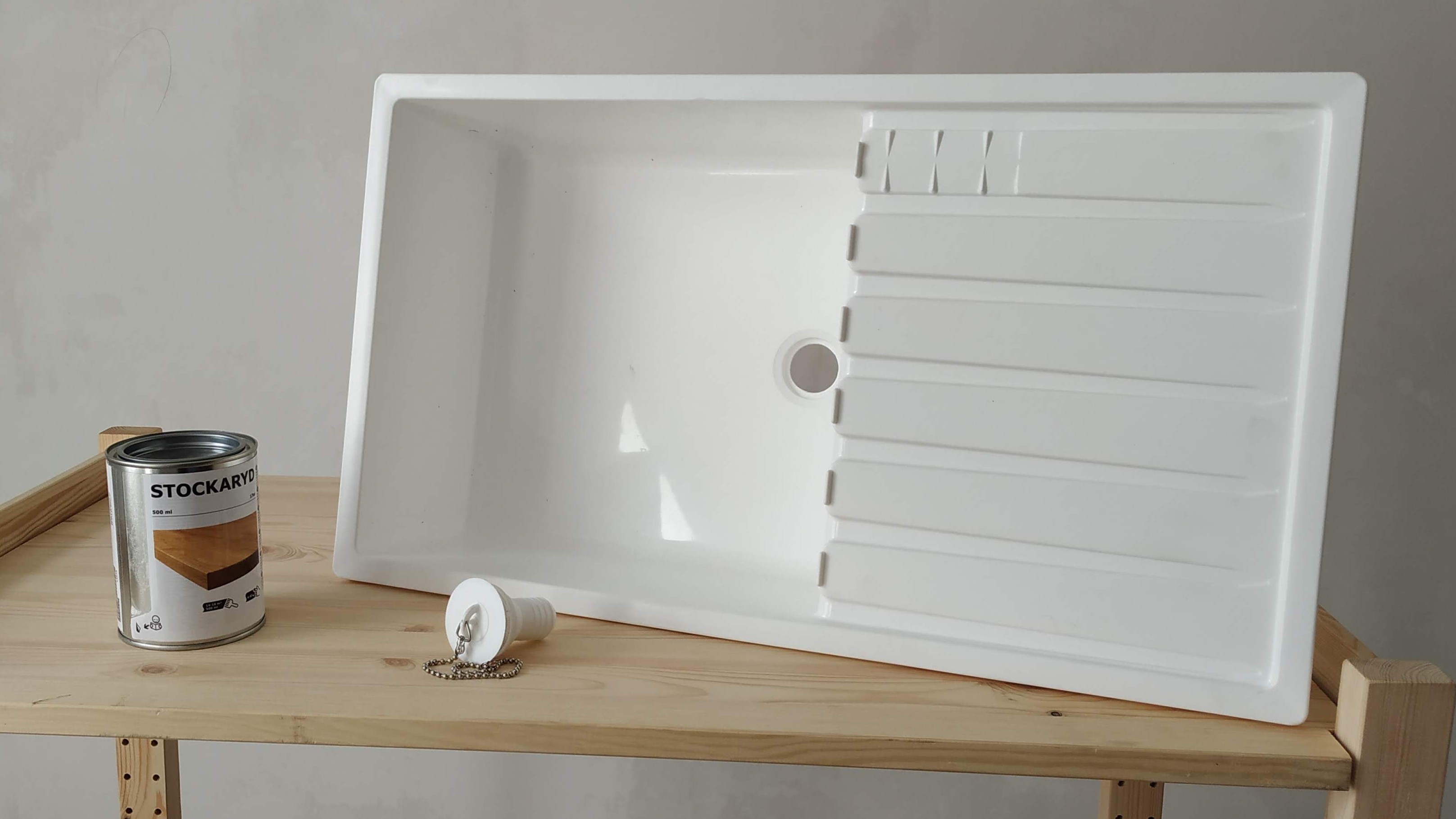
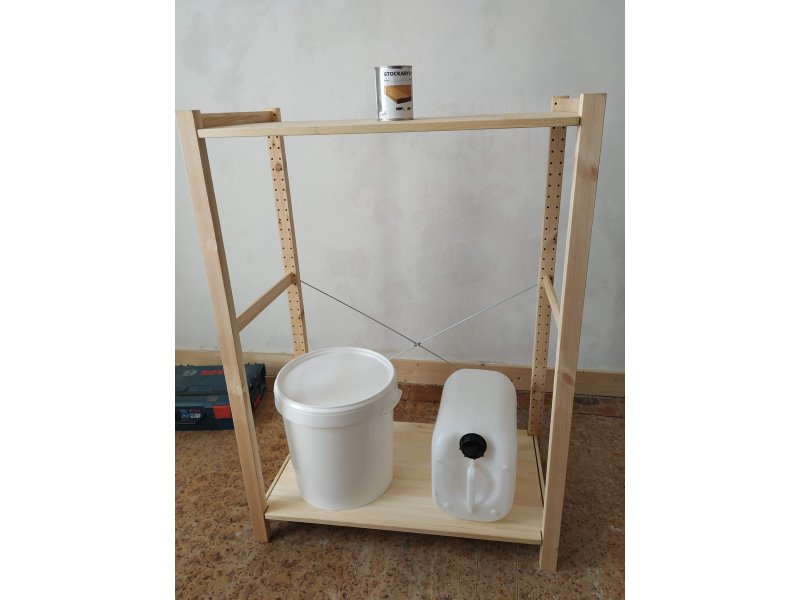
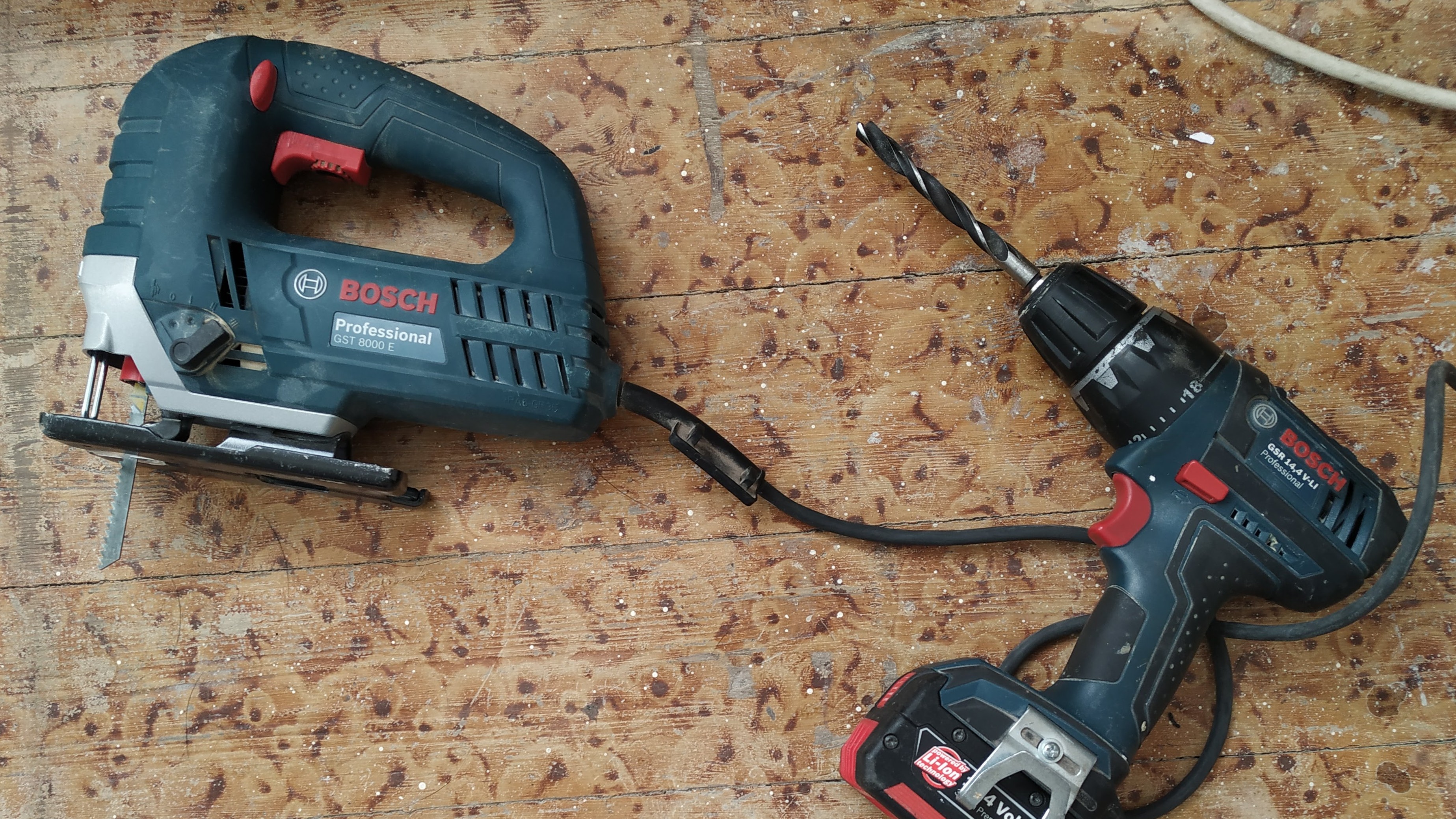
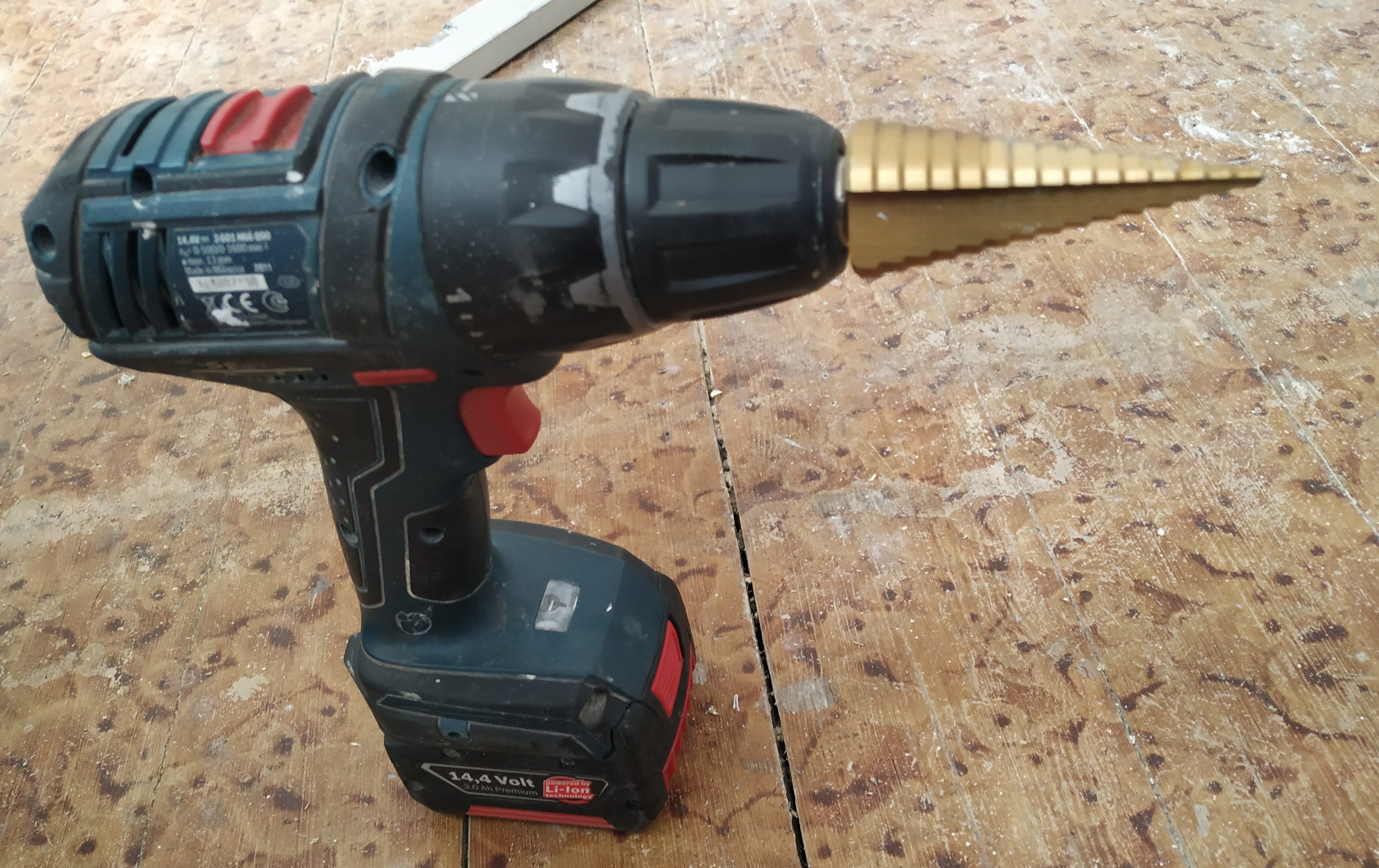
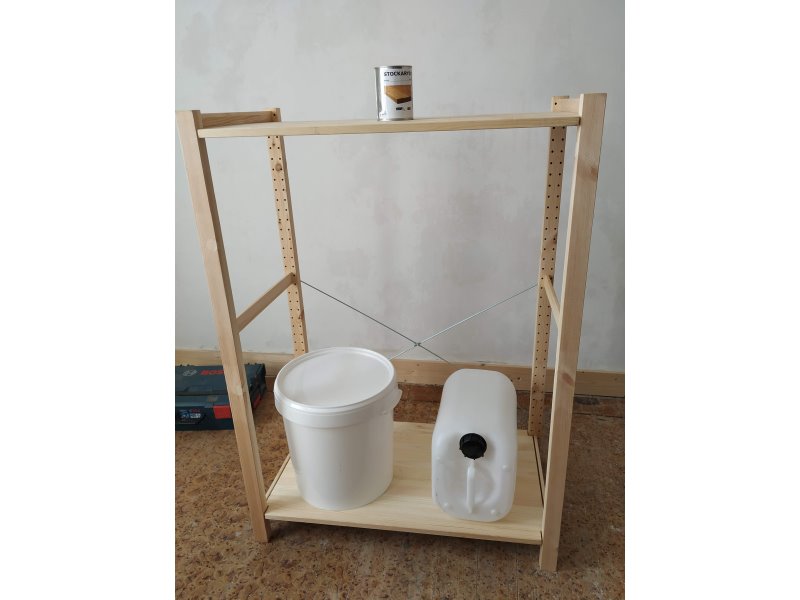
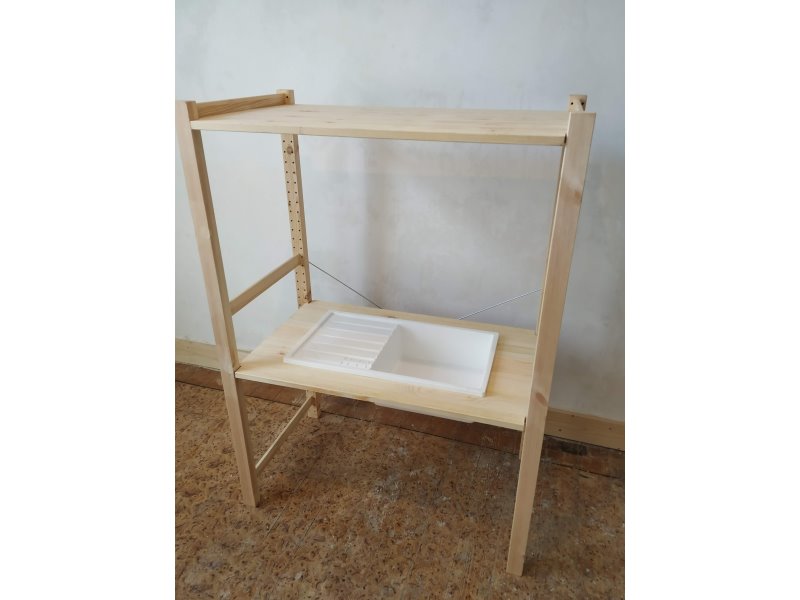
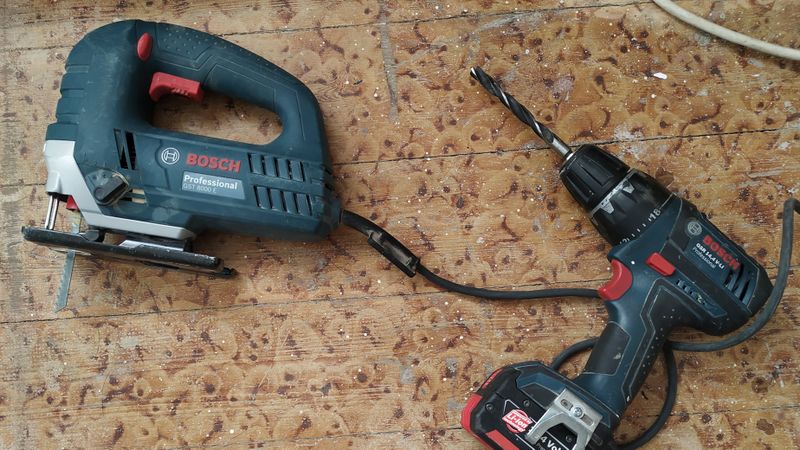
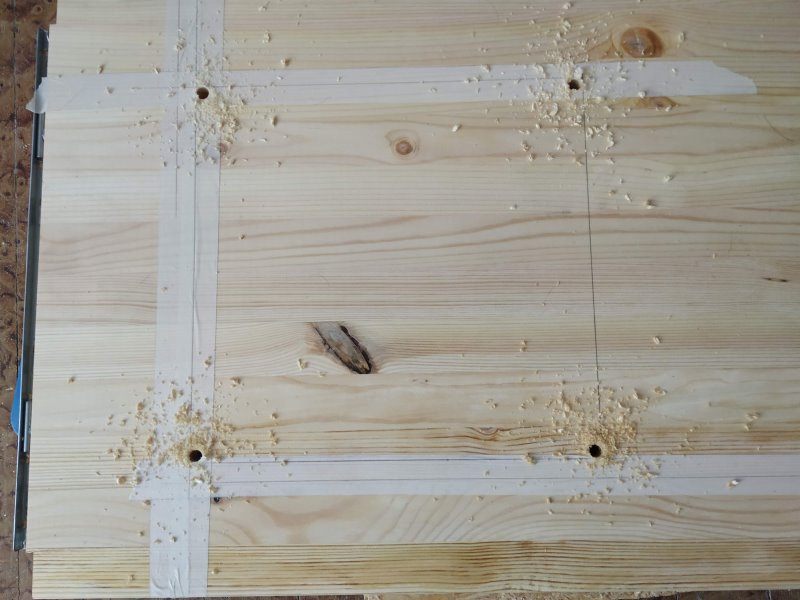
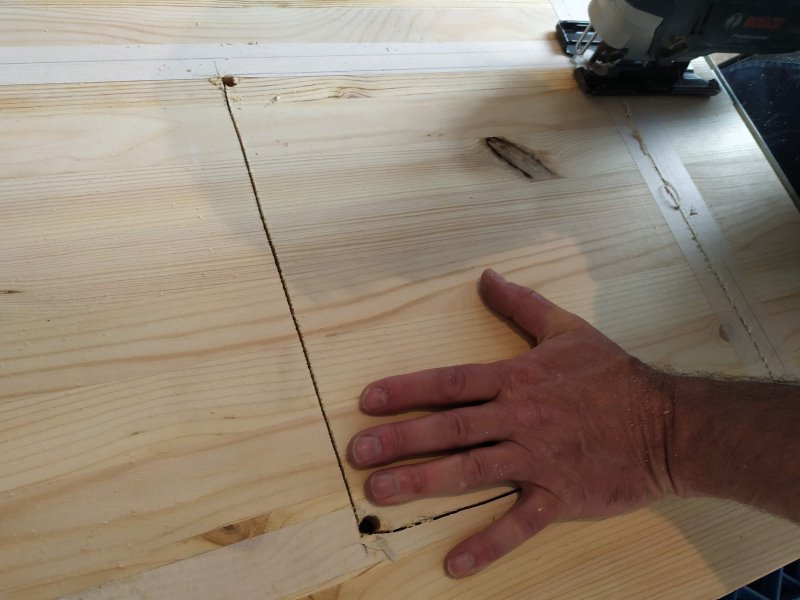

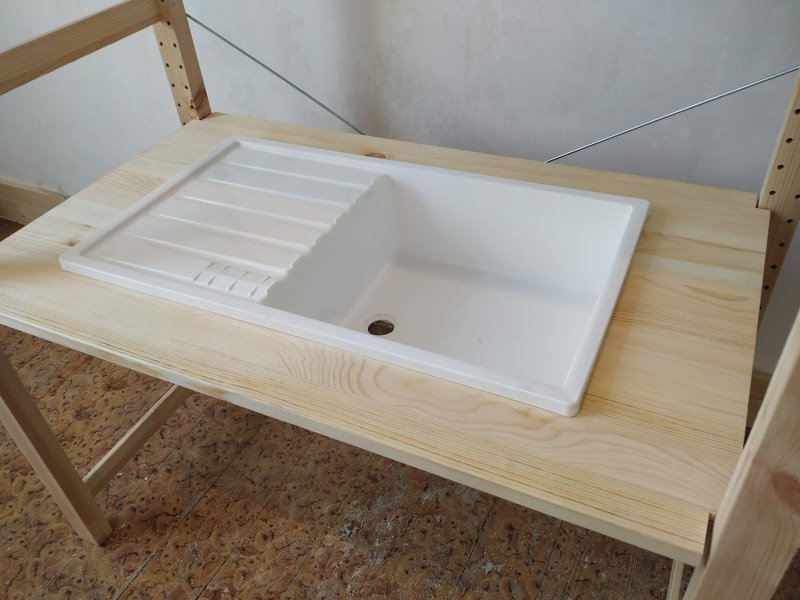
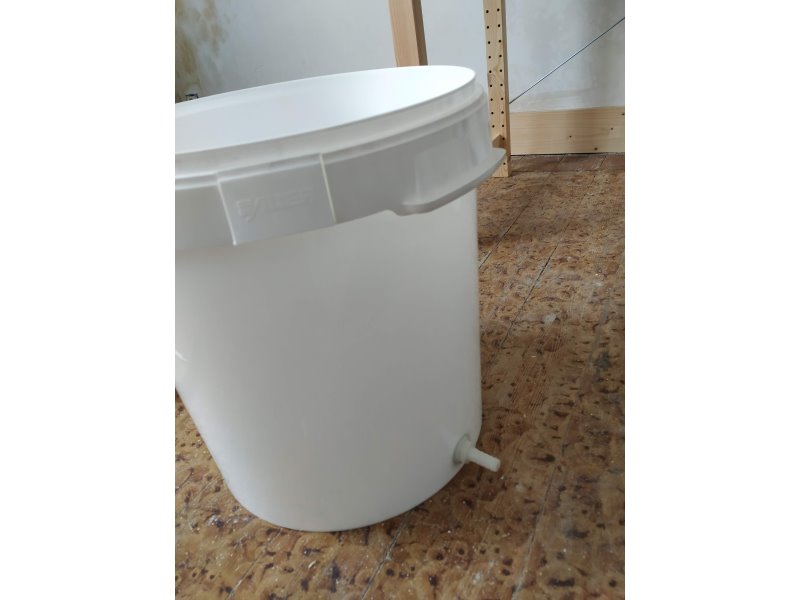
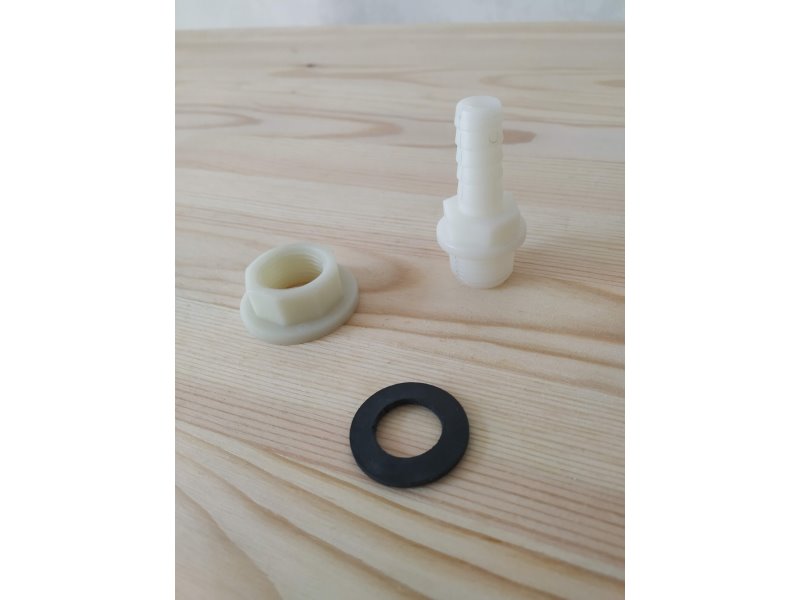
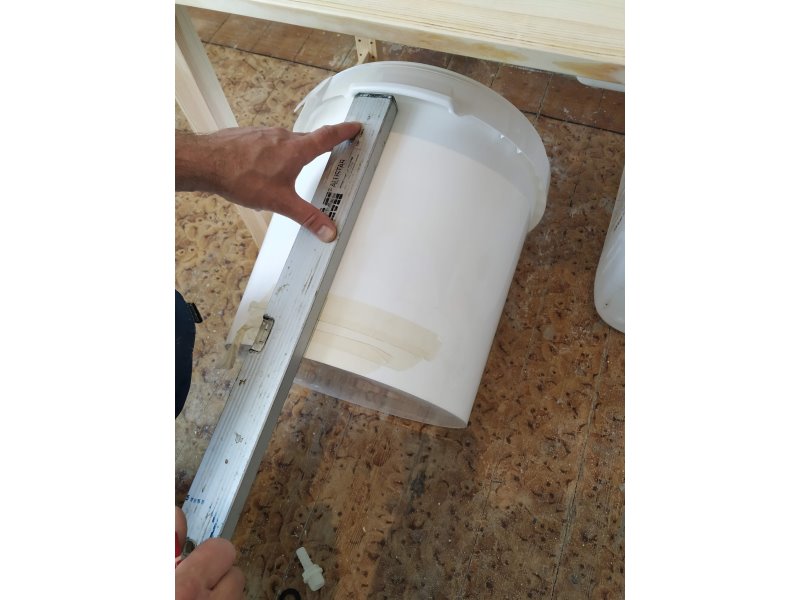
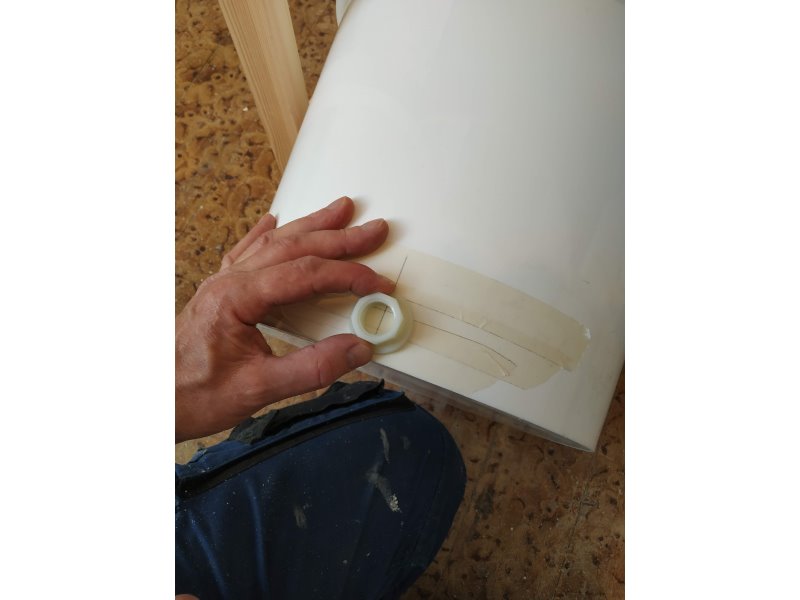
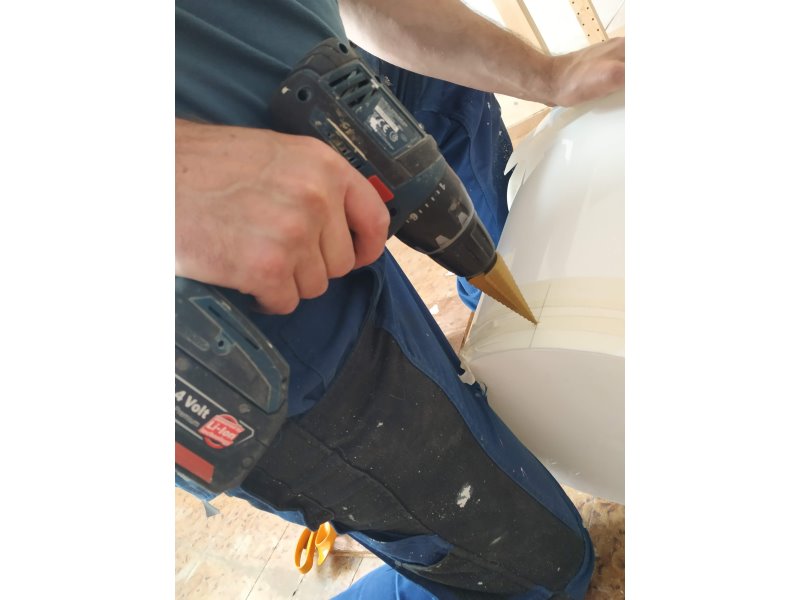
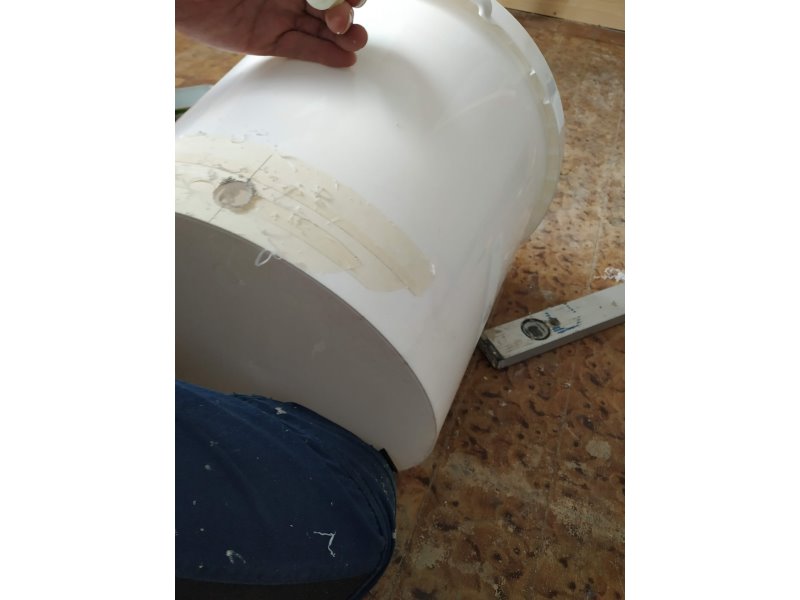
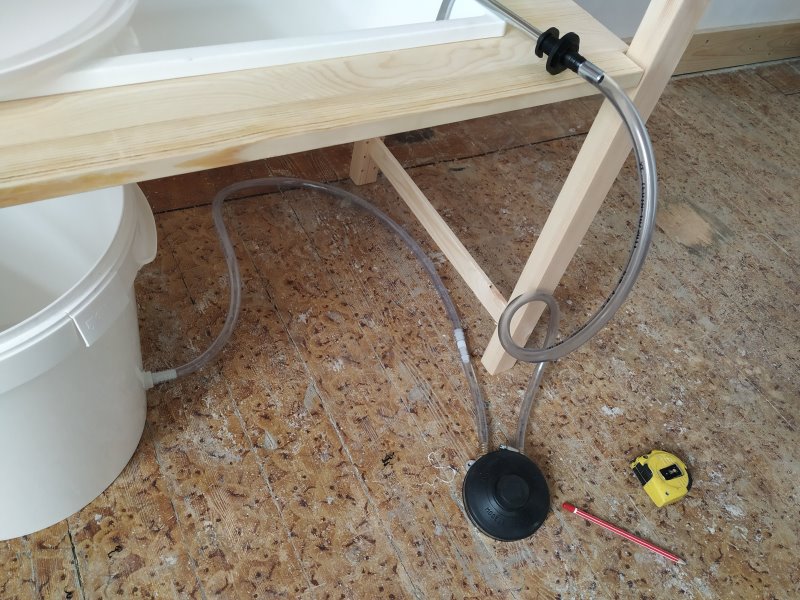
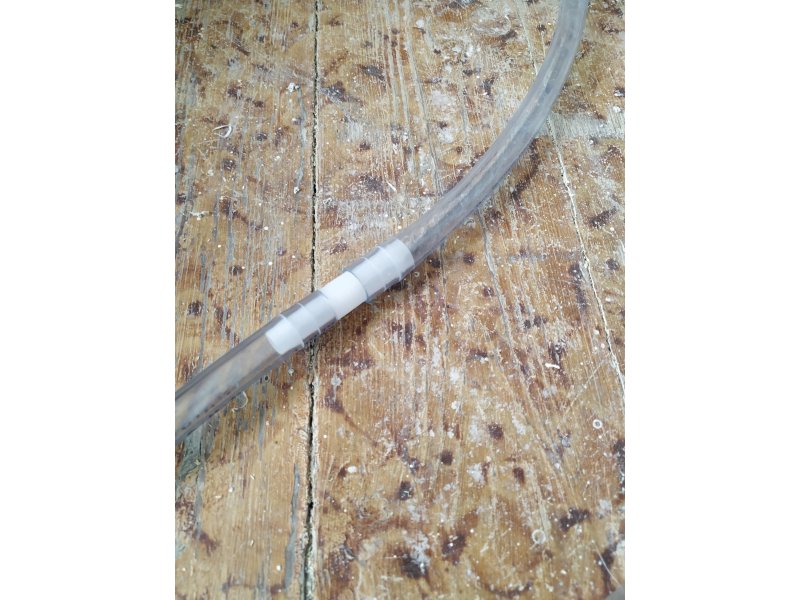
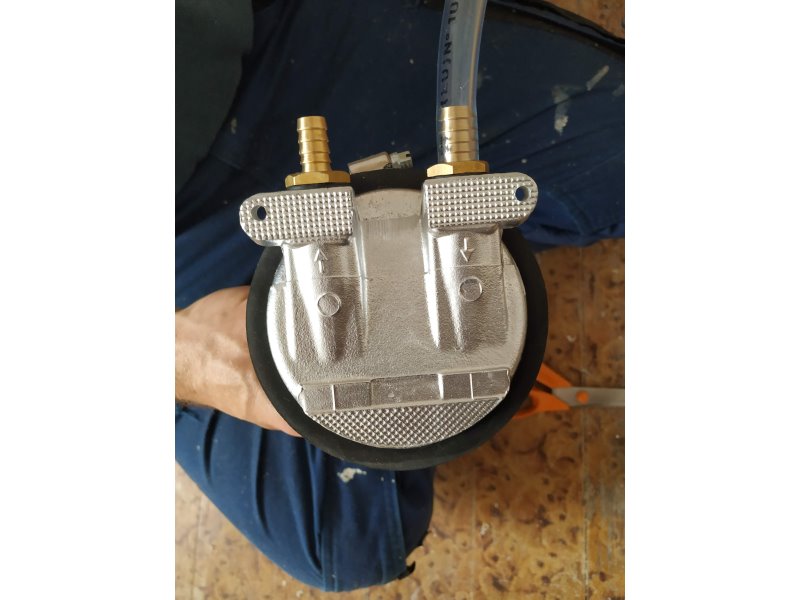
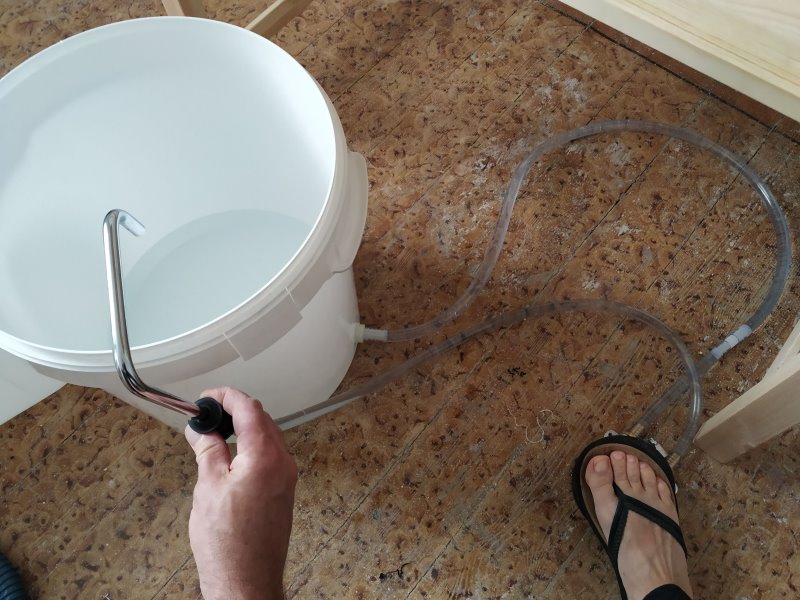
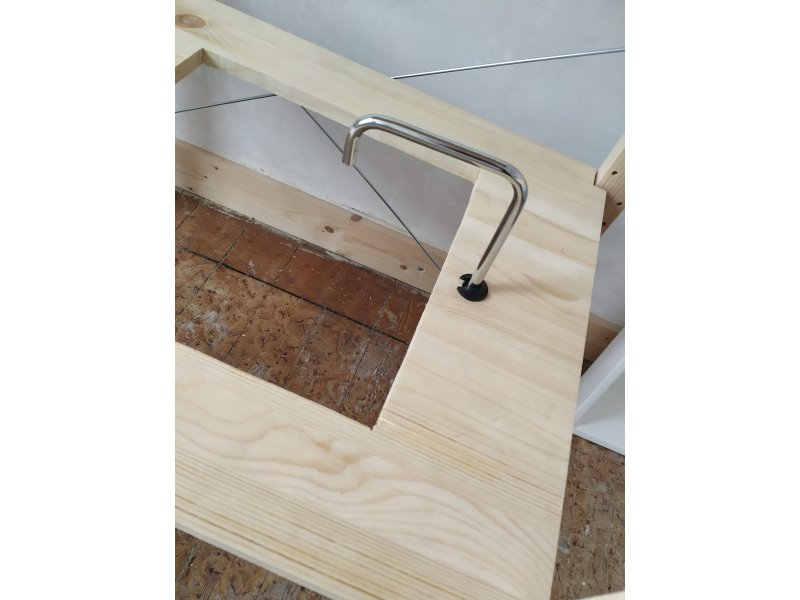
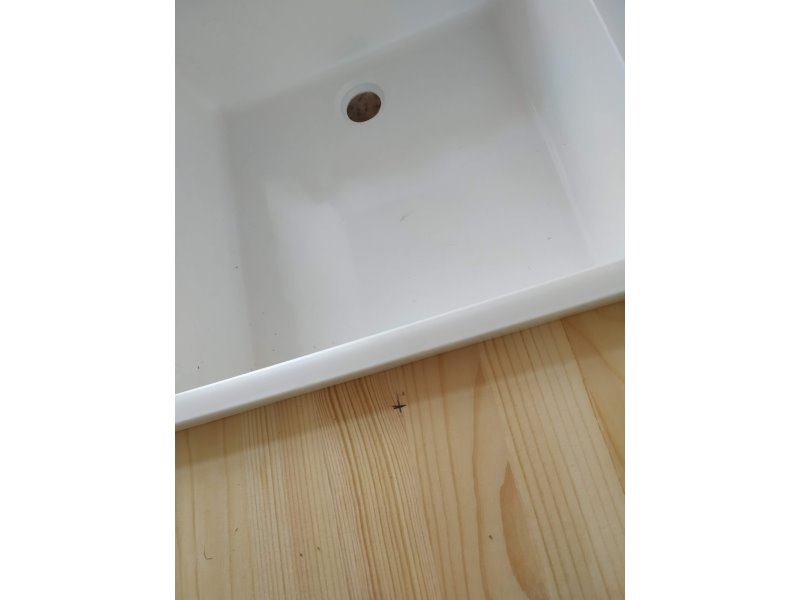
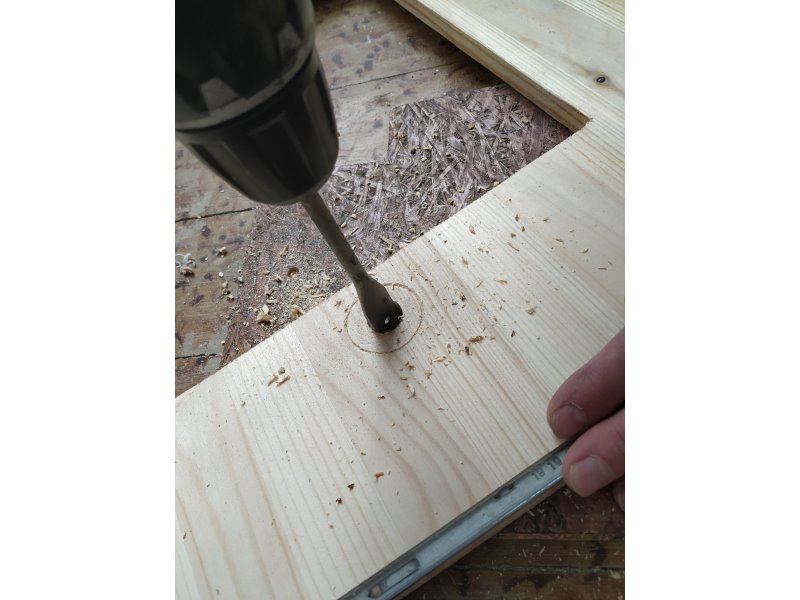
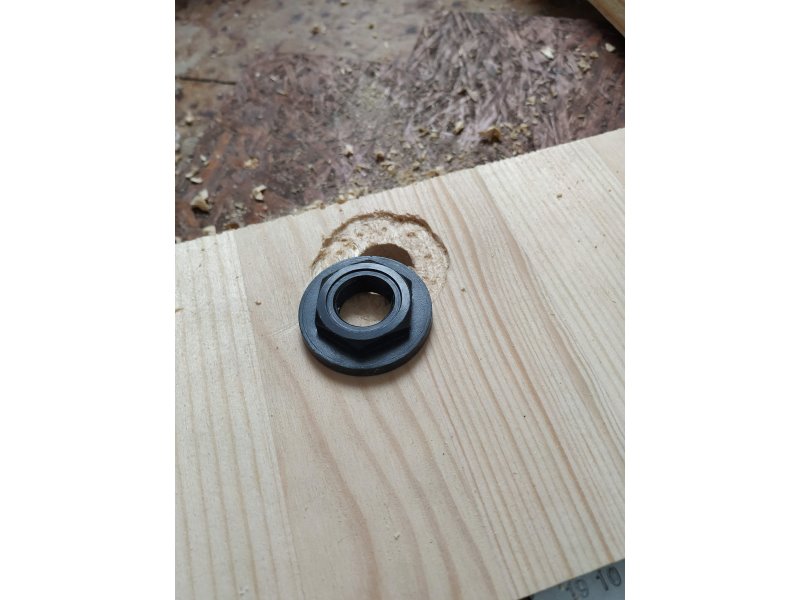
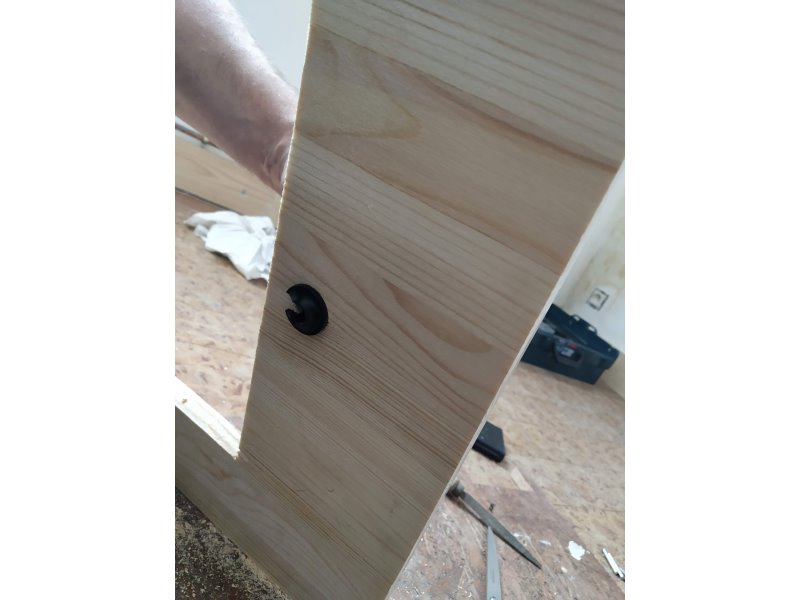
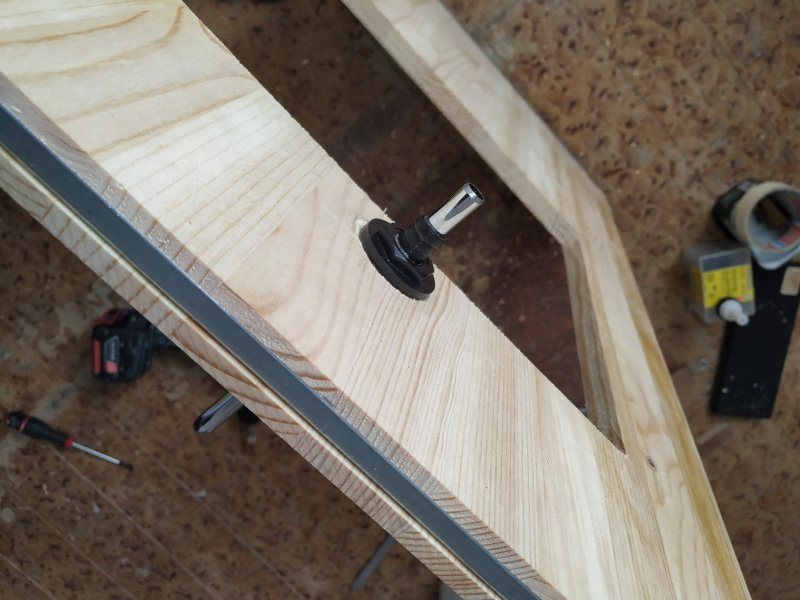
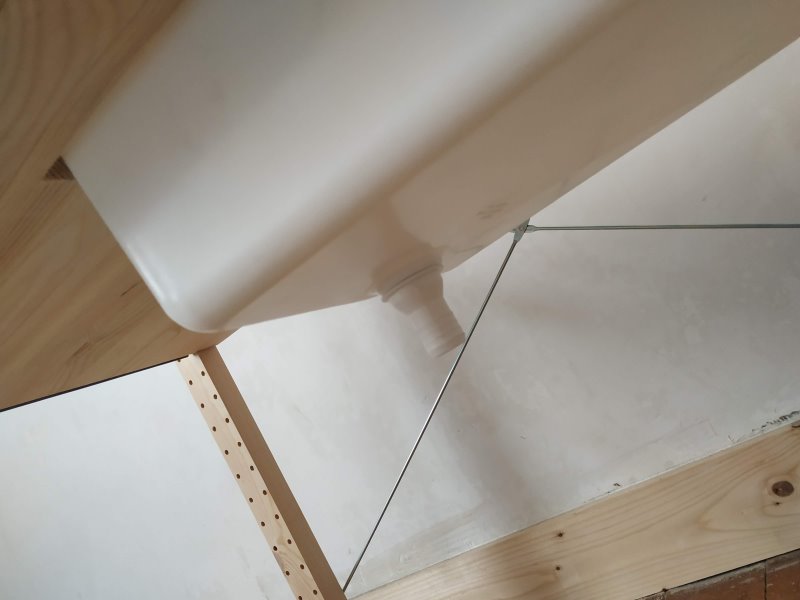
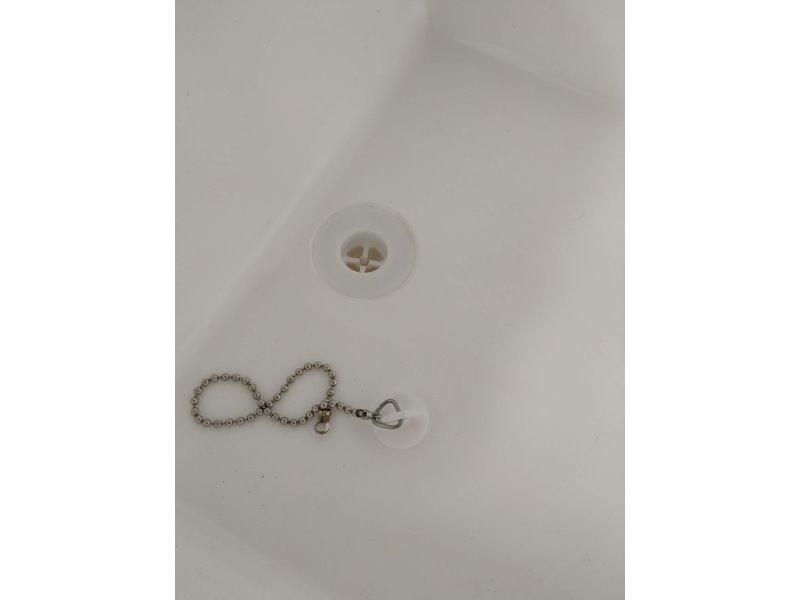
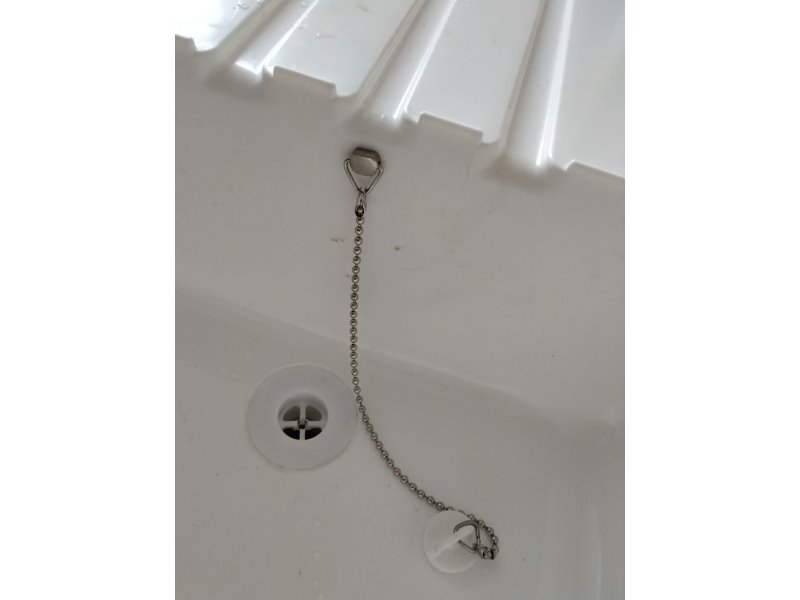
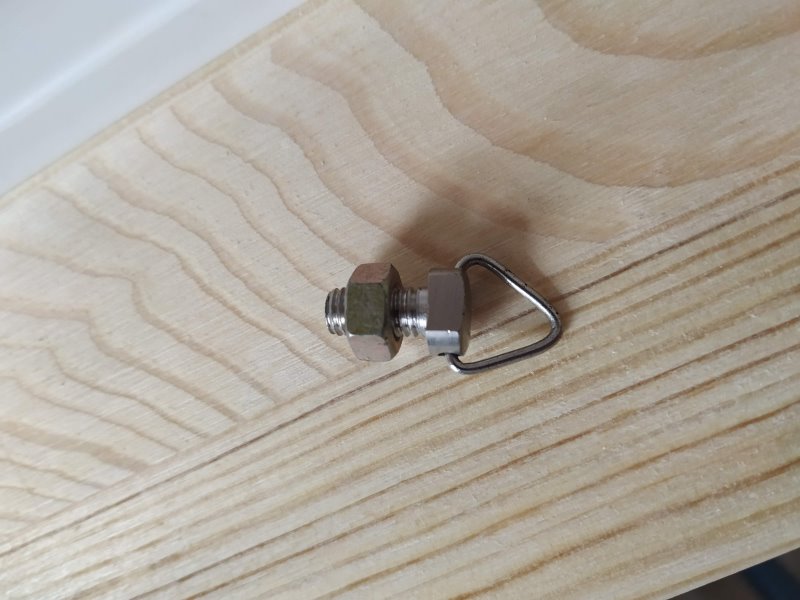
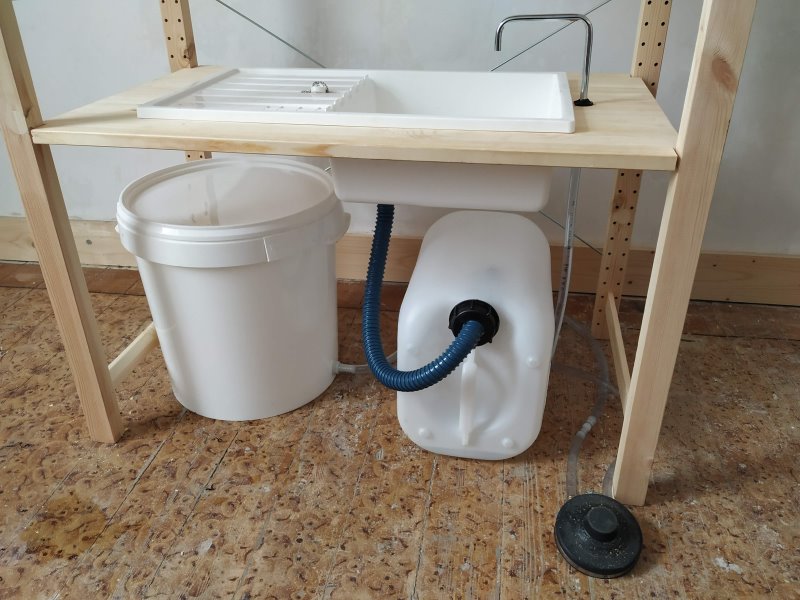
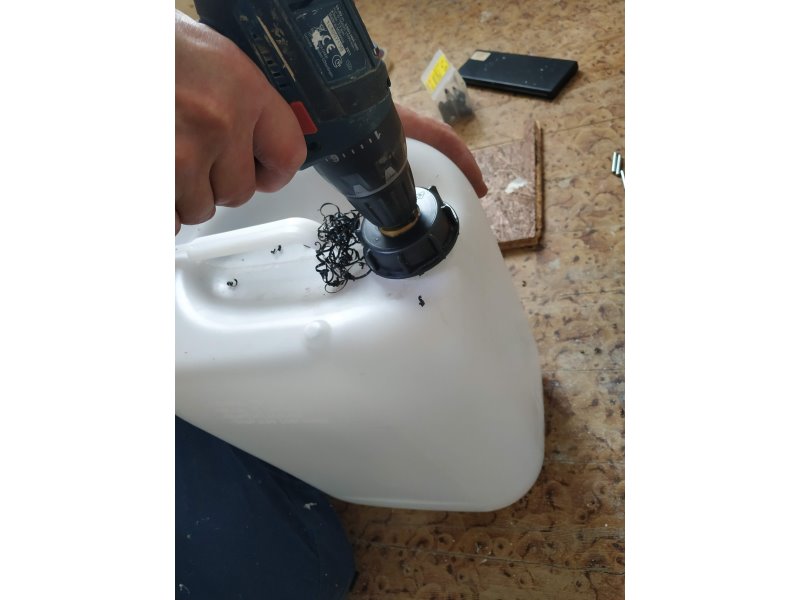
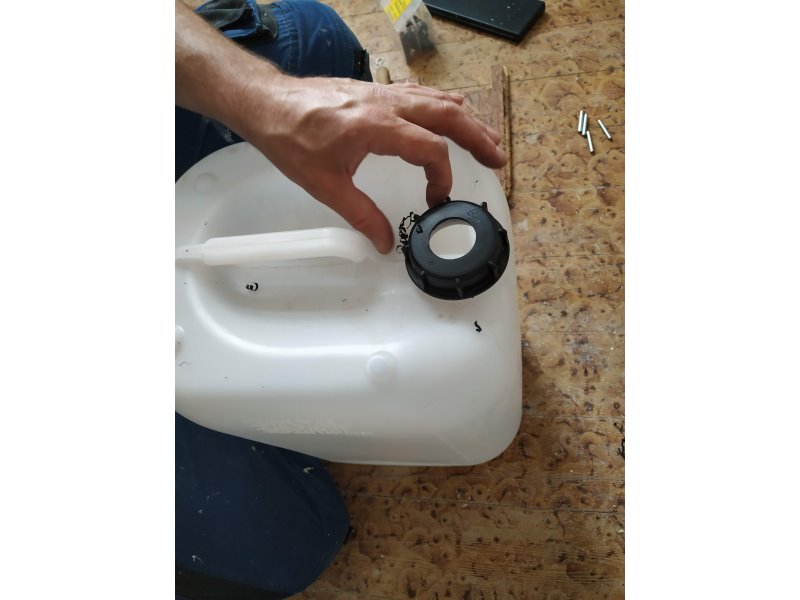
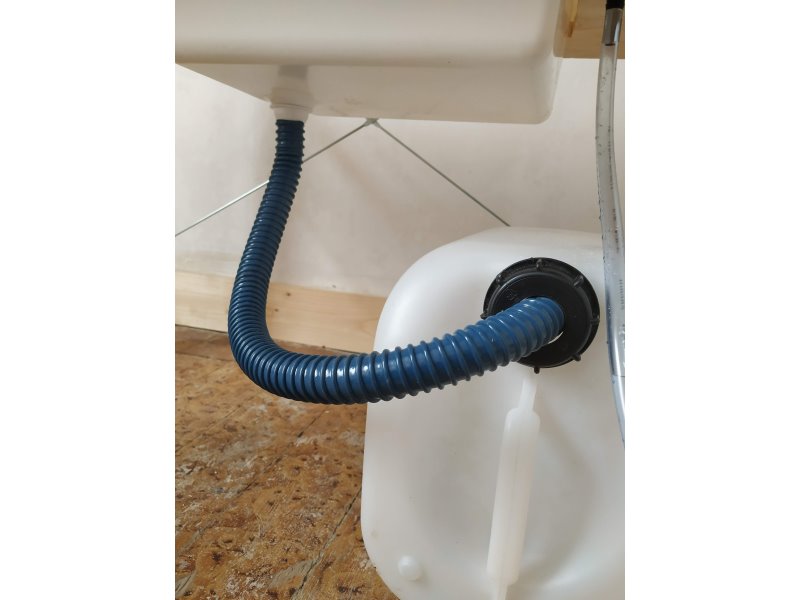
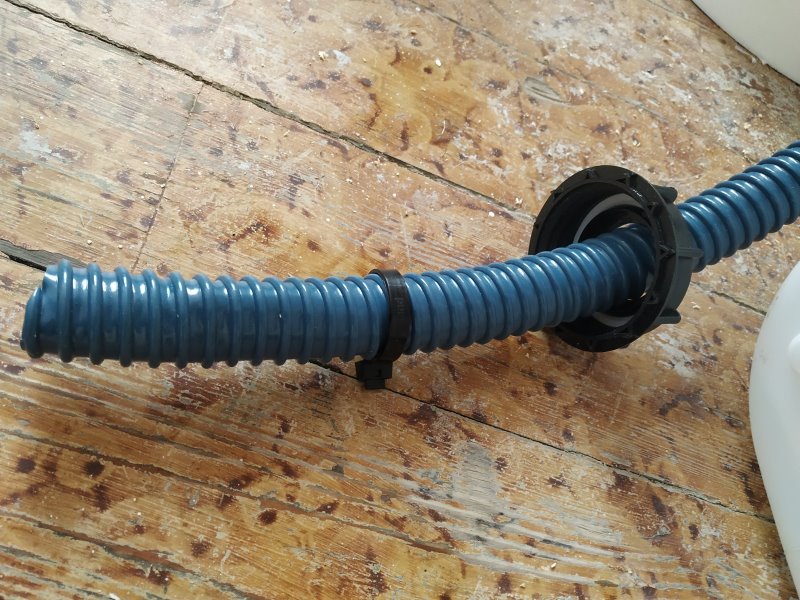
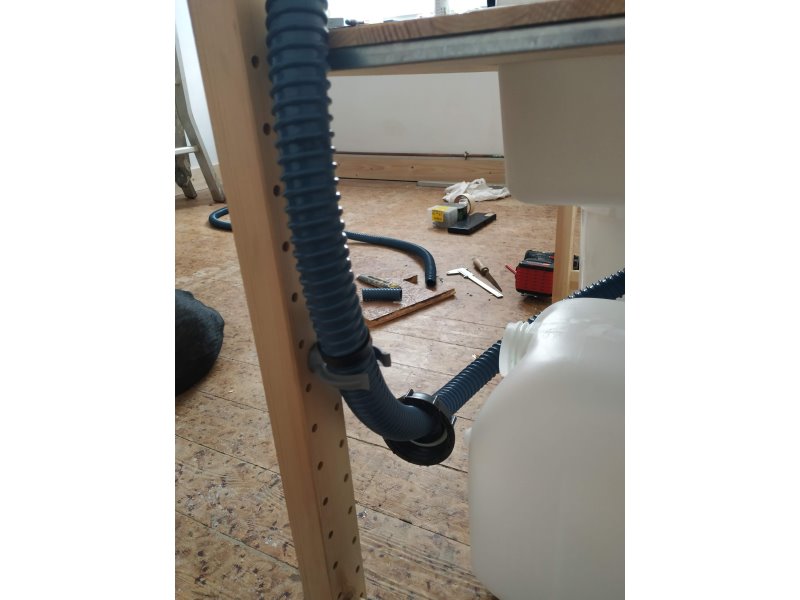
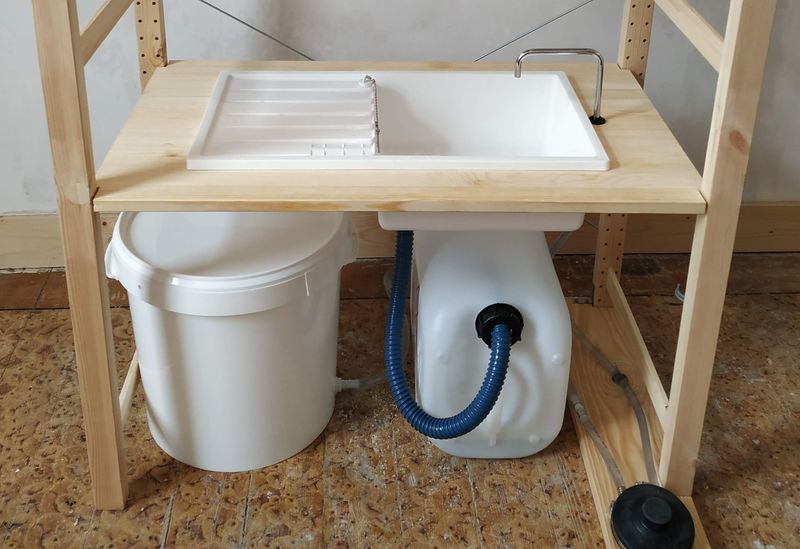
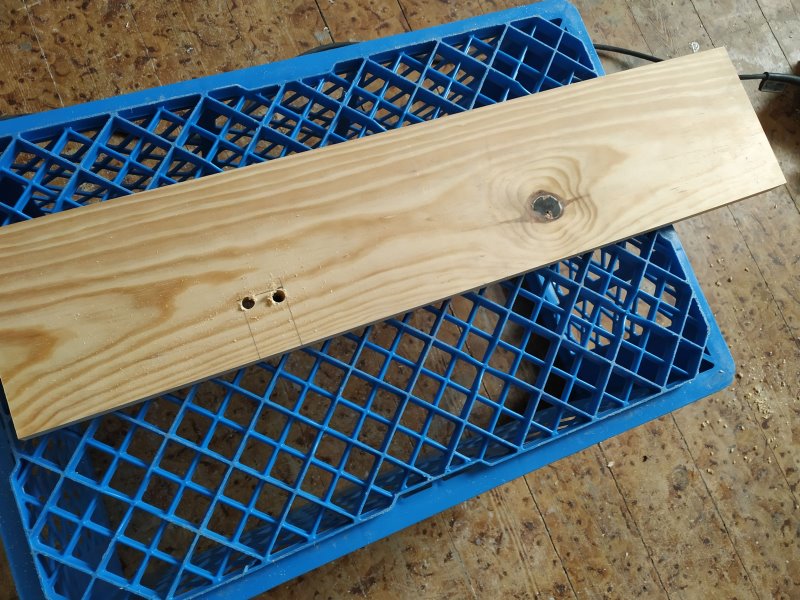
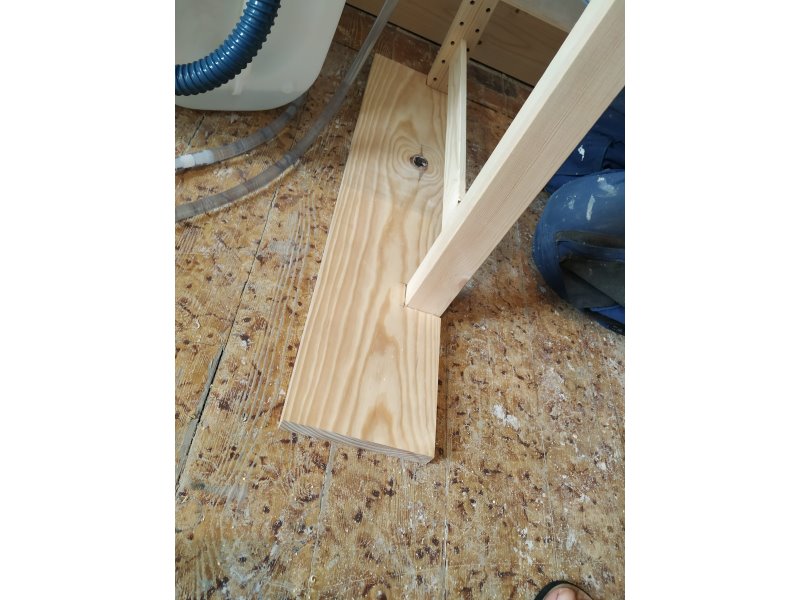
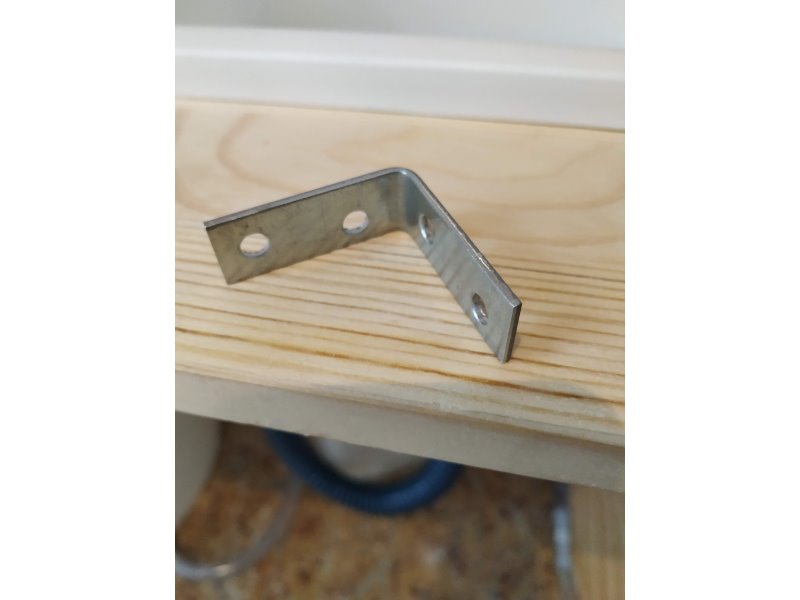
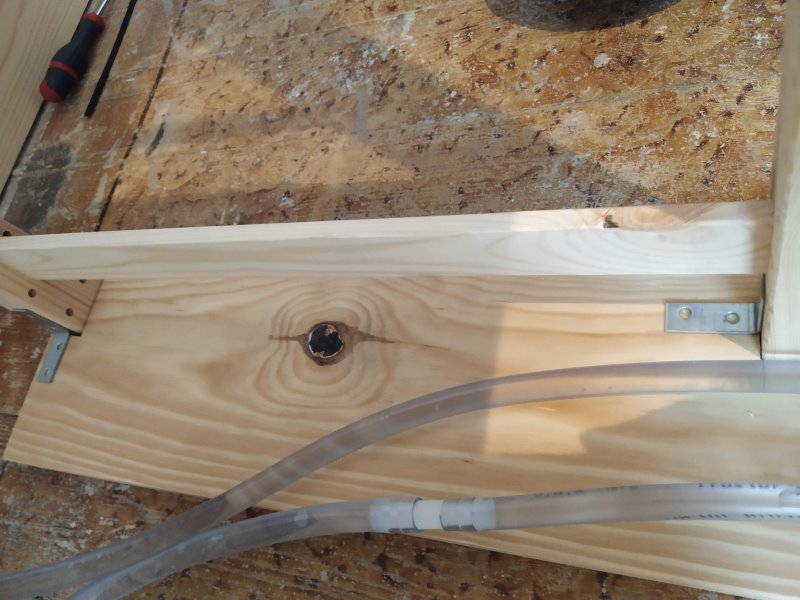
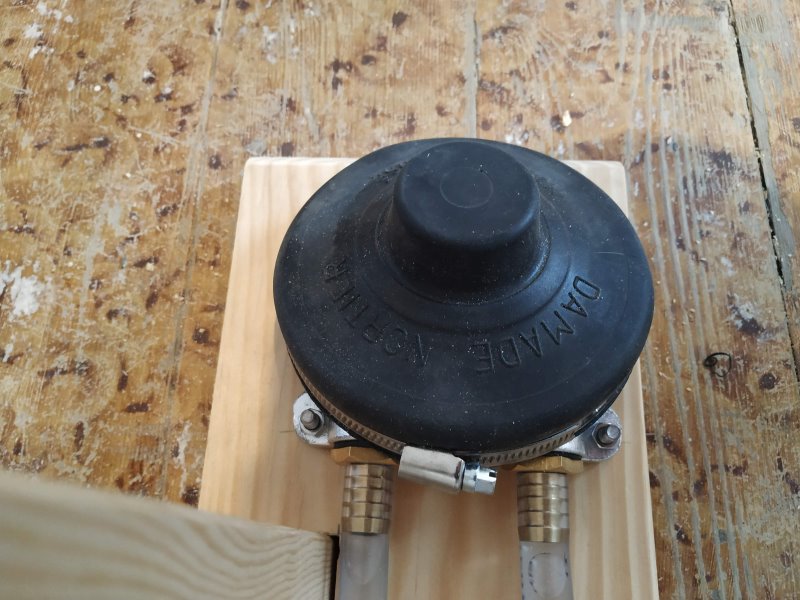
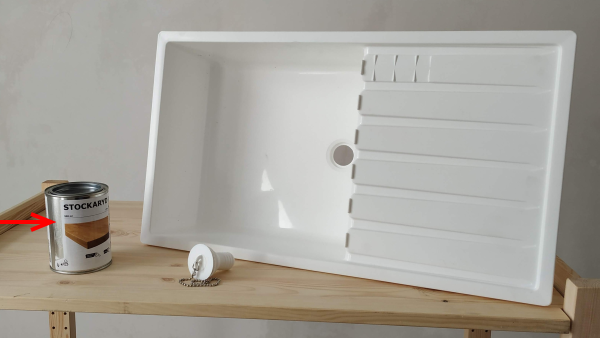
 Français
Français English
English Deutsch
Deutsch Español
Español Italiano
Italiano Português
Português